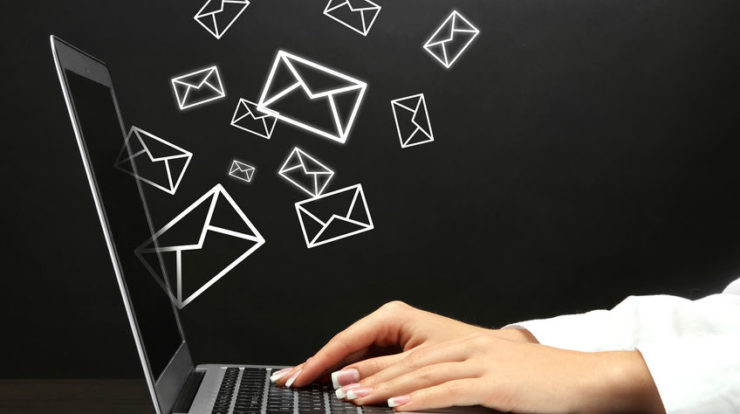
I often receive questions from artists about the best methods for following up with potential buyers who don’t acquire the art they’re interested in right away. In the following email exchange and excerpt from How to Sell Art, I go through my recommended follow-up practices:
Hello Jason!
Thank you for presenting your Webinar on selling artwork. It was well-presented, interesting and while nothing in there is surprising or magical, like your booklet, Starving to Successful, you laid out practical essential steps for commercializing our products.
After thinking about the presentation for a day, I realized that most of my sales are not really the type you talked about. When I do sell that quickly, I’m usually represented by a gallery. As an artist, most of my sales are done in a long drawn out process. For instance, I hope to close soon with a guy who first saw my work about five years ago in a gallery. We have met several times and he is just coming around to commissioning at least one piece and probably some architectural installation pieces for his yet to be remodeled home.
Another couple have admired my work for years, but we just have not been able to close with something. They are in Santa Fe and I am in California. I have visited them, They have been here. They really wanted a particular and expensive piece twice. We went through a long negotiation both times, but we just couldn’t find enough common ground. First they said they were waiting for their new house to be built and the second time it was too much money. I take them at their word and I still think they are good candidates for something, but its so frustrating.
In a similar vein, my studio sales are ecelectic: each one seems unique, word of mouth, or some place that they saw my work so its very hard other than generally to keep producing and sending things out, how to advertise or expose my work to gather a larger audience. Casting large scale glass work limits my production and makes the prices high. I’m sure the numbers game is even harder in this case.
I hope you see that the two problems are related. Do you have any suggestions? One thing you did suggest, that I have not been perfect at, is the follow up, the personal note and even the thank you gift, something I have barely considered, although I have sometimes thrown in the original drawing or conceptual sketch with my cast glass sculpture. Usually, I don’t have the psychological advantage of being in the moment when the decision to buy happens
thanks again.
DAVID
My Response:
David,
Thanks for attending and for the question. I do understand the sales scenario you are describing where it is not a spur of the moment kind of sale. We run into this same kind of situation when we encounter clients who become interested in major works by sculptors we are representing. That is that the initial interest may not lead to the sale for many months or even years.
Good, systematic follow-up is going to be the key to making these sales. Using the follow-up guide in the slides and in my new book How to Sell Art will be a good start, but then sustaining that follow-up over the following months (or as long as it takes). I am including an excerpt from the book below that will give you some ideas of the follow up we do with clients.
Set a goal to follow up with every lead at least once every 6 weeks until they buy or tell you explicitly that they have decided they are not interested.
If they are interested in a specific piece, keep sending images of that piece. If they are just generally interested in your work, start sending images of new work.
Jason
Excerpt from How to Sell Art:
Chapter 10 | When all Else Fails, Follow Up
As has been established in earlier chapters, there will be times when you are unable to close the sale on the spot, despite your impressive expertise. Even if you do everything right, there is no guarantee of success, written or otherwise. Clearly, in the best of worlds, business is concluded on the initial visit – you are happy, the collector is happy, and everyone can breathe a sigh of relief.
But what if all does not go as planned? What then?
In the case of the runaway shopper, you ought to have a system of operation in place that addresses the practice of follow up. But for follow up, each and every “unclosed sale” that walks out your door is lost forever.
The follow up requires care, continuity, and consistency. Be careful not to irritate your customer with incessant communication. Do only as much follow up as is reasonable to prevent the lead from growing cold. Continue to exude cheerful optimism and good will with each contact.
It is ultimately too little contact that dooms the potential for a sale. I have found that it generally requires seven to ten follow up communications to close a deal. Giving up after the first or second attempt demonstrates a defeatist policy unworthy of the master sales guru.
In the next pages, I will share an outline of my follow up regimen, which you can then adapt to your particular situation and requirement. While I follow the basic format, I do customize each communication to the client, referencing our earlier encounter and our previous conversation. I want each contact I make to feel unique and personal.
Gather Contact Information
I am far more interested in getting my customer’s follow up information than I am in giving him a brochure or business card, and then hoping for the best. Giving out a brochure or business card is a last resort – this happens only after I have successfully obtained his contact information, or have been rebuffed in every attempt to do so.
You are going to have a hard time following up if you don’t manage to collect your client’s contact information. Gaining access to this information requires skill. It is a vital precursor to the line-up of steps leading to the deferred sale. Instead of requesting his credit card for an immediate closure, you are requesting his private, personal, and precious contact data as the means whereby you can stay in touch.
To reiterate: Do not seek this information until all other attempts to sell have failed. Because it is easier to gather contact information than it is to close a sale, you may be incentivized to extract the address early in an encounter. However, when you let the ease of collecting an email address tempt you to focus your sales efforts here instead of where they should be – on making the sale – you are writing your own license to fail. RESIST THIS TEMPTATION!
The ideal way to get a client’s contact information is to write it on a sales slip as he is handing over his credit card. Always put your energy into making things happen to fit the ideal; don’t make the drill more difficult than it has to be by delaying the sale.
Now that we have that out of the way, let me share a few of my secrets for acquiring contact information. Though it is indeed easier than making a sale, it does demand a bit of finesse.
People are understandably reluctant to share their phone numbers, both land and cell, and their addresses, both snail mail and email. We live in an age in which we are bombarded with advertisements, solicitations, and notices – JUNK. No one is excited about the prospect of receiving additional unsolicited calls and mailings.
Fortunately, when you’ve done a good job of laying the foundation for a relationship, your client will trust you not to misuse his information. You can commiserate about over-loaded inboxes and intrusive phone calls.
“Oh, that we could escape the deluge! I can’t blame you for wanting to restrict additional access to your inbox and mailbox and phone lines!”
With all of this in mind, give careful consideration to how you ask for the address.
Asking outright, “May I have your contact information?” is likely to push a person into automatic defense mode. He will surely bristle at the suggestion that he should be expected to summarily surrender his privacy.
Try instead, “Would you like me to email you an image of this piece? I can include the dimensions and additional detail for you.”
Better yet, take an assumptive approach. In my gallery, I have client contact cards secured on small clipboards. When a customer prepares to leave the gallery, I extend a clipboard and a pen and say, “I will email you an image of the piece along with dimensions, pricing, and additional detail.” Make this a cheery, breezy overture, and watch it work like a charm.
People have a tendency to be equable, and to follow the path of least resistance. The best part about getting the client to fill out the contact form instead of directly asking for the information is that he will indubitably fill out the entire form, giving not only an email address, but a physical address and phone numbers as well.
Now, to make good on the promise of an effectual paradigm for following through on the follow up.
Follow Up #1 | Immediately After the Encounter | Thank the Customer and Provide Information.
My first follow up typically occurs immediately after my interaction with the customer. I sit down at my computer and compose an email while our meeting is fresh in my mind. Often, the customer receives the message in his inbox (or on his Smartphone) before he is down the block.
A typical email reads something like this:
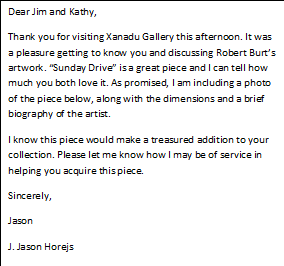

I include a digital image of the artwork, either directly in the email or as an attachment.
I always make sure to test my emails to ensure that images are coming through with the email. This can be (as anyone knows) trickier than anticipated. I know it’s got to be tricky because I often receive messages from artists who think they have included an image, when all I see is an empty box, or an unopenable attachment.
Unfortunately, I cannot disclose a list of failsafe steps to make certain that the images are coming through, as the list will vary with individual operating systems and email carriers. I can, however, recommend that an artist or gallerist send tests to friends on Macs and PCs, and then confirm that they are able to open the email and view the images, and that the format of the email is easy to read and looks good.
When one runs into problems, the internet is replete with helpful forums that dispense assistance in correcting settings and maximizing operative effectiveness. Assistance is always as close as your keyboard and your computer screen.
Follow Up #2 | Four Days After Initial Contact | Thank-You and Confirmation of First Email
Often, the first email will fail to elicit any response, or may get only a brief acknowledgement. That’s okay – I merely want my client to see how efficient I am, and how sincere I am in my commitment to provide superior service.
My next email is intended to elicit a response and to initiate a renewed dialogue.
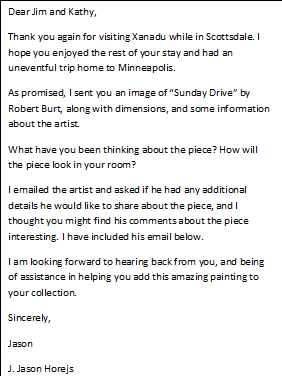

Notice everything I am attempting to do here. First and foremost, I am keeping the communication as personal as possible. The last thing I want is for this letter to feel like it is a cut-and-paste form letter. Hence the use of first names and the reference to the trip back home.
In the second paragraph, I am working to establish a sense of obligation and connection between us. I am delivering on my half of the contract by fulfilling my promise to communicate, with the expectation that “Jim and Kathy” will pay me the courtesy of a response.
In paragraph three, I have let the customers know I am going the extra mile to provide additional, valuable information. I am putting time and effort toward helping them make the decision, rather than waiting around for them to send me a check.
Asking the artist to write a few words about the piece is great not only for the client, but for me and the artist as well. It provides me with additional information about the piece that I would not otherwise have, and gives me an opportunity to alert the artist that I have someone interested in his work. I am careful when doing this not to build expectations too high. On the one hand, I don’t want my artist disappointed if the sale doesn’t ultimately close, but on the other, I generally find that he is thrilled to be told there is interest in and activity on his work. In his desire to be accommodating, he is more than happy to give me a few words.
To be honest, I occasionally do a bit of editing upon receipt of an artist’s response. When I have it tweaked, I put the information on file, along with the image, so I can readily access it when I have someone else interested in the same piece.
In the event the artist is acting as salesperson for her own work, she has undoubtedly already informed the interested party concerning the background of the piece, and likely has nothing new to share. That’s okay; she need only remind him in writing what she shared when he was visiting. It will heighten the significance of the artwork in his estimation when he reads the words of the artist, detailing her own work. A response from him is typical for this second email.
Follow Up #3 | Four Days After Initial Contact | Mail a Letter and Printed Picture of the Piece
If I have a physical address for the client, the same day I am sending email #2, I will also send out a letter via the good-old-fashioned post office. This letter is hand-written and hand-stamped. Though it is going to mirror much of what I have already said in my emails, I want to hit them on every possible front. Getting something tangible and tactile into their hands will sometimes work when an email won’t.
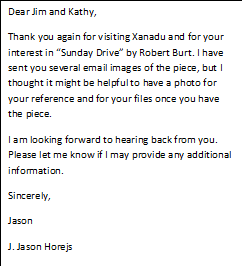

I often include a printed copy of the artist’s bio in this letter, as well as anything I have from the artist that references this particular piece. The weight of the additional detail tends to further stimulate an interest in what is perceived to be a significant work of art.
Follow Up #4 | Phone Call | Seven Days After Initial Contact
If Jim and Kathy have provided a phone number, don’t hesitate to pick up the phone and call them when a week has passed since the initial contact. Make the call pleasant, brief, and friendly.
“Mr. Smith, this is Jason from Xanadu Gallery in Scottsdale, AZ – how are you, sir?”
“Fine, Jason,” Mr. Smith responds, “How are you?”
“I’m very well, thank you. I am calling to confirm you received my emails regarding ‘Sunday Drive’ by Robert Burt.”
The customer, in all likelihood, says thanks for the email and offers an excuse as to why he hasn’t gotten back to you.
“That’s no problem – I can imagine how busy you are. I look at the piece every day in the gallery, and I remember how much you and Kathy enjoyed it. I just want to make sure you have all the information you need to acquire the piece.”
The phone call gives the salesperson the advantage of being able to ask fundamental questions, to follow up with specific questions, and to utilize the client’s answers to uncover his concerns. With this information, the artist or gallerist is better able to allay Mr. Smith’s reservations.
Follow Up #5 | Nine Days After Initial Contact
The further one gets into the follow up process, the more difficult it becomes to adhere to a set pattern. Much of the activity will now be dictated by the knowledge derived from the clients’ responses to the first couple of emails. As the process progresses, the communication should grow more personal. In essence, the attempt now becomes that of recreating, then building upon, the original face-to-face overtures to close the sale. The channels of email, snail mail, and telephone must now suffice as the only means to make contact with Jim and Kathy.
If I am not getting much response from the buyer, my general strategy is to reiterate points I have made in previous communications, through the retelling of the story that accompanies the art. I provide supplementary tidbits of biographical information about the artist. I sprinkle in details about the positive response Jim and Kathy expressed when they saw the art for the first time. The goal continues to be to engage the clients in the conversation, and to evoke a response.
These communications (typically emails) are going to be brief but personal. I don’t mind if Jim and Kathy start to feel like they owe me some kind of reply for all my efforts – there really is a method to my madness!
Each subsequent email includes a digital image of the piece, and relays another detail of interest.
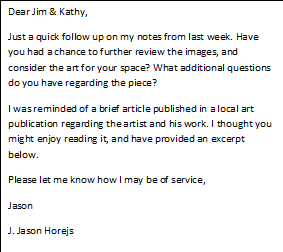

While I sincerely do want to continue to provide useful information to the collectors, my communication has now effectively become a battle of attrition. If I manage to keep the emails and letters buzzing, eventually Jim and Kathy are going to wear down and respond, even if their response is only to tell me to knock it off because they are no longer interested.
A common concern among both gallery staff and artist is a fear that if they keep trying, they run the risk of irritating their customers. I have never found this to be the case, and even if it were to happen, I would prefer to risk upsetting a customer than to risk the possibility of not making a sale. If I do not orchestrate a persistent follow up, I do not close a sale. It is that simple.
Remember, customers are busy with work, family and life. Even when they mean to respond, they sometimes don’t because life gets in the way. Jim and Kathy deserve my best follow up enterprise.
Simply put, I would rather receive the irritated email asking me to stop, than to give up, never knowing whether I could have made the sale had I persisted a bit longer. I am doing a good thing when I strive to facilitate the collectors’ desire to procure a wonderful work of art. I have no reason to apologize, and no cause to be ashamed.
Follow Up #6 | 14 Days After First Contact
If I have not received any communications after a couple of weeks, it is time to start digging a little deeper and pulling out some bigger emotional artillery. I will now dig for guilt if I have to (though I will do so with subtlety) and I will start taking some measured risks to elicit a reaction.
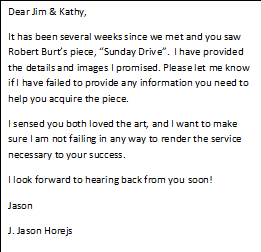

Follow Up #7 | 21 Days after First Contact
At three weeks out, I pull out all the stops and rush in head-long to win the customers’ attention. I make an offer I have held in reserve prior to this point in time.
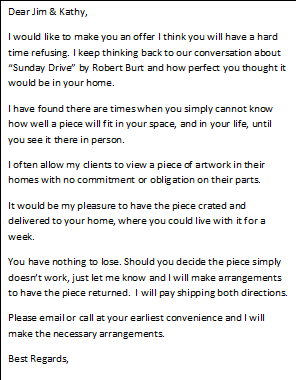

As I said, I do not make this offer up front – it could delay a sale. Some customers will respond to the first or second communication (this would be ideal of course), and decide to buy the piece. I wouldn’t want to delay that purchase by offering to send the piece out on approval before the 7th email.
At this point, however, it’s time to make something happen. By offering to pay for the shipping in both directions, I have removed any risk for the collectors to try the piece. I have found there is typically little risk involved for us, as most clients who are willing to have the piece shipped to them are also likely to purchase.
When to Give Up
What if I don’t make the sale after the seventh contact – should I give up? No!
Even if the client hasn’t yet been willing to commit to the purchase, the possibility of the sale somewhere down the road still exists. Continued follow up requires some effort, but because the possible benefit so far outweighs the cost, it just makes sense to practice persistence.
I have had many cases in which a sale came months down the road, and only after many, many contacts. As I write this book, I am working on a sale that began over nine months ago.
The clients found a piece in the gallery they felt would be perfect for a new sunroom addition to their home. At the time of their first visit to the gallery, they were in the midst of remodeling and weren’t (in spite of my best salesmanship) ready to make a commitment.
I promptly initiated my follow up process, knowing that it was likely to take some time to put the sale together. After an initial response, the clients went silent. I made a reminder to myself to follow up down the road. Six months after our meeting, I sent another email and got a response from the wife that they were actually nearing the end of their reconstruction project, but had run into some unexpected expenses. However, they remembered the piece, and requested that I check back again in several months.
Of course I did check back, and we are now actively negotiating to close the sale. In our most recent series of communications, I rolled out the full presentation, and included a note from the artist wherein he again expressed his enthusiasm about the piece.
I cannot be certain the sale will close successfully, but I can be certain that had I given up after our first round of correspondence, I would never have had the opportunity to re-open the conversation and have a shot at the close.
I remember an instance several years ago in which I closed a sale only after several dozen communiqués, stretched over the period of six months! In that instance, it truly was a matter of patiently persisting until the time was right for the customer.
Craft and implement a follow up system that will enable you to keep your efforts organized and consistent. While we presently keep track of our clients in a computer database, perhaps it would make more sense for someone else to use a manual system to organize his client list, similar to the one we used when we first opened the gallery.
In that system, we used the address card (see Chapter 3 | What’s in a Name?) to record a client’s information, and then moved the card through a series of folders as we followed up. For example, every Monday we went through the files and looked at everyone’s cards, and followed up with whichever step corresponded to his placement order in the folders. Each client would get a note, email, or phone call, after which his card would be transferred into the next file, where it would be handy for the next step in follow up. It was customary to jot a note on the back of the card regarding the follow up and any response we received.
Come up with a system that works, and then stick with it. Follow up consistently and persistently, and your sales will increase. Guaranteed!
(Of course, a side benefit of all of this following up is that your client is going to have a hard time forgetting who you are. Even if he does not purchase now, he will think of you the next time he considers adding to his collection.)
Keep Evolving Your Follow Up Protocol
I consider this chapter a work in progress. Simply put, this is my current follow up system; ask me again in a year’s time, and the notes and follow up protocol will have further evolved.
In writing notes and following up consistently, you will find your own voice and develop the system that works best for you. I encourage you, no matter what the system is, to strive to be consistent and persistent in your follow up with each and every client.
Learn more about selling art by ordering How to Sell Art today.
This is so interesting! Thanks for your generosity in sharing your expertise here. I must say this goes against my nature, but now I will attempt to follow up instead of
letting them go when an interested customer doesn’t reply. I hope the galleries who represent my work read your blog!
Thank you very much for this information. It’s very helpful to those of us who are a bit shy with not a clue. Your steps can be easily tailored to a number of sales instances. I feel a more confident to begin the process of “Follow Up”.
Thanks again,
Have a successful season.
Thank you so much for all the interesting info so looking forward in ordering your books. Living in a remote part of Newfoundland , Canada you don’t have a Galley that you can visit everyday so most of my works I sell on line from my website or social media but I will be in the near future be putting a package together for a Gallery hint hint also I was ask to do a solo show this Sept in Ontario so by getting your book will help me big time . Thank you so much
Great article! My big worry always is whether the original email I got was correct or perhaps misinterpreted from what they scribbled down on the entry sheet. Is it appropriate, reasonable to push for verification on that and the fact that it hasn’t gone to their junk folder?
Also – Love to know what contact management database system you use…
I always ask to read the email back to them. Generally I say, “I tend to work on my emails at night and I want to make sure I don’t miss anything!” I’ve corrected a LOT of my reading of other people’s handwriting that way. 🙂
I would like to know your thoughts on printing and selling AI produced art that does not plagiarize other images. I know this is an issue with a lot of my artist friends. Thanks
Thanks for sharing such detailed insights on follow-up strategies! I struggle with maintaining consistent communication with potential buyers, especially when the initial interest fades. Do you have any tips for adapting these methods to online sales platforms?